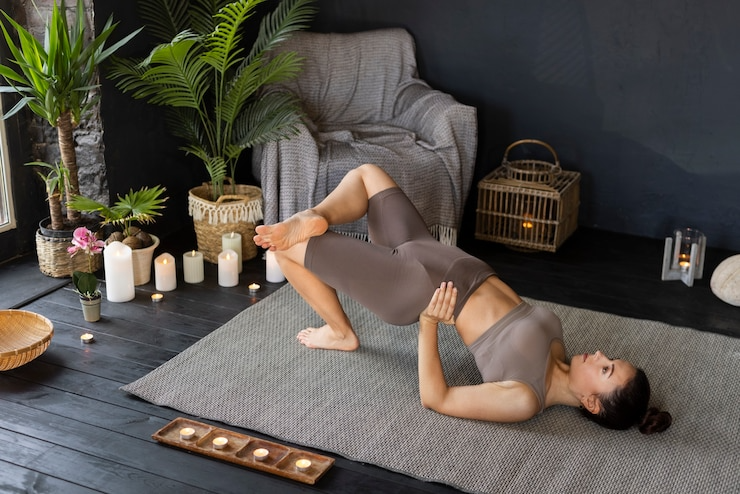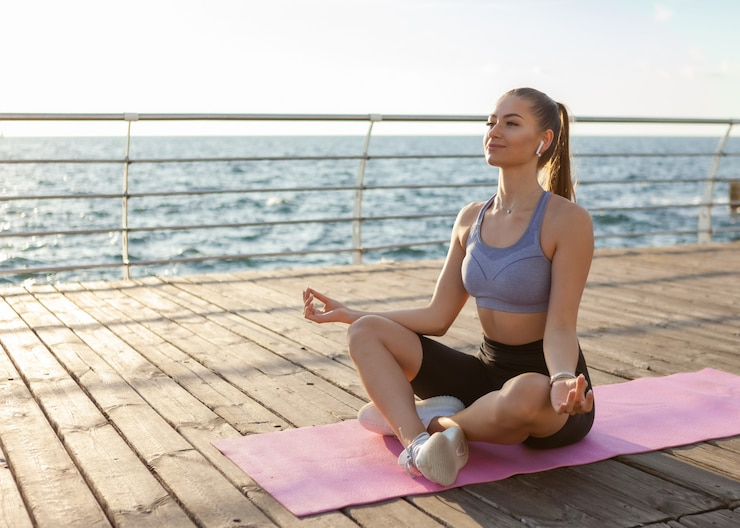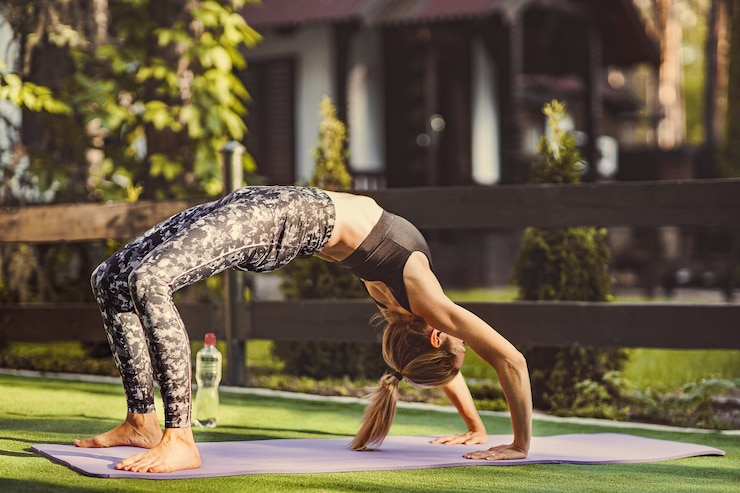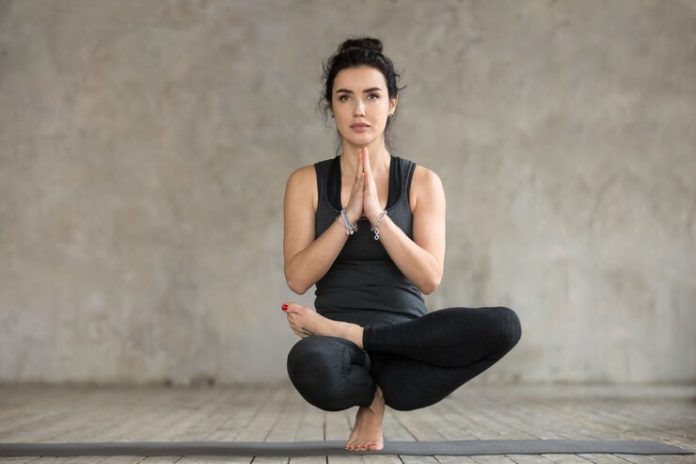Yoga poses—those graceful and seemingly impossible bends and twists—have captivated the world for centuries. But yoga is so much more than just physical postures. It’s a holistic practice that combines physical movement, breathing exercises, and meditation for a complete mind-body experience. This comprehensive guide will delve into the diverse world of yoga poses and practices, making them accessible to everyone, from curious beginners to seasoned yogis. Whether you’re looking to improve your flexibility, reduce stress, or simply enhance your overall well-being, this exploration will equip you with the knowledge and inspiration to embark on your own yoga journey.
Popular types of yoga
1. Hatha yoga
Often referred to as the foundation of yoga, Hatha yoga focuses on the physical practice of yoga poses (asanas) and breathing exercises (pranayama). These hatha yoga poses are designed to strengthen and tone the body, improve flexibility, and increase range of motion. The practice emphasizes proper alignment and mindful movement, making it suitable for beginners and experienced yogis alike. Through a sequence of hatha yoga poses, practitioners not only build physical strength but also cultivate inner awareness and a sense of calm. Many popular yoga styles, such as Vinyasa and Iyengar, have their roots in Hatha yoga, making it a cornerstone for a well-rounded yoga practice.

2. Vinyasa yoga
Vinyasa yoga, also known as flow yoga for its seamless transitions, is a dynamic and popular style of yoga. Unlike Hatha yoga with its set poses, Vinyasa strings postures together in a flowing sequence, creating a sense of movement and dance. Each breath acts as a bridge, synchronizing movement with inhales and exhales. This rhythmic flow can be invigorating and build cardiovascular endurance. Vinyasa classes can vary in intensity, from powerful sequences designed to build strength to gentler flows that focus on mobility and flexibility. The beauty of Vinyasa yoga lies in its adaptability ;it can be tailored to different fitness levels and preferences, making it a versatile practice for anyone seeking a physically and mentally stimulating yoga experience.

3. Iyengar Yoga
Iyengar Yoga stands out for its meticulous attention to detail, precision, and alignment in yoga poses (asanas). Unlike some flowing styles, Iyengar Yoga prioritizes holding poses for extended periods, ensuring proper form and maximizing the therapeutic benefits of each posture. Props like blocks, straps, and bolsters are a hallmark of Iyengar Yoga, allowing practitioners of all abilities to achieve optimal alignment and safely access various asanas. This focus on precision and the use of props make Iyengar Yoga a valuable practice for those seeking to improve body awareness, correct postural imbalances, and enhance their overall yoga practice. Whether you’re a beginner or a seasoned yogi, Iyengar Yoga offers a structured and rewarding approach to yoga, empowering you to explore your body’s potential in a safe and mindful way.

4. Restorative Yoga
In contrast to the dynamic movements of Vinyasa or the precise alignment of Iyengar, Restorative Yoga offers a gentle and introspective practice focused on deep relaxation and stress reduction. Restorative yoga poses (asanas) are held passively for extended periods, often supported by props like bolsters, blankets, and blocks. These props allow the body to completely surrender and melt into the pose, minimizing strain and maximizing comfort. During a restorative yoga session, the focus shifts inward, allowing for deep breathing and mindfulness practices. By quieting the mind and body through these restorative yoga poses, practitioners can experience a sense of rejuvenation, improved sleep quality, and a reduction in muscle tension and fatigue. This gentle practice is perfect for those seeking a calming and restorative yoga experience, regardless of their fitness level.

Unwind, De-Stress, and Find Your Center with Our Calming Yoga Class
5. Bikram Yoga
Crank up the heat! Bikram Yoga, also known as Hot Yoga, is a unique and challenging style practiced in a room heated to a scorching 105 degrees Fahrenheit (40 degrees Celsius) with 40% humidity. This intense environment allows for deeper stretches and increased sweating, promoting detoxification and a feeling of purification. A Bikram yoga class follows a specific sequence of 26 bikram yoga poses (asanas) and two breathing exercises performed in the same order every time. The heat can be daunting for beginners, but proponents claim it loosens tight muscles, improves flexibility, and boosts circulation. It’s important to listen to your body and stay hydrated throughout the practice. Bikram Yoga isn’t for everyone, but for those seeking a physically demanding and sweat-inducing workout, it offers a unique and challenging experience.
6. Yin Yoga
In contrast to the heat and exertion of Bikram Yoga, Yin Yoga offers a calming and introspective practice that targets the deeper connective tissues of the body. Yin yoga poses (asanas) are held passively for extended periods, typically 3-5 minutes or longer, with minimal muscle engagement. This allows the connective tissues, ligaments, tendons, and fascia to gently lengthen and release tension. Unlike the dynamic movements of Vinyasa or the precise alignment of Iyengar, Yin Yoga encourages stillness and mindfulness. Many yin yoga poses are performed seated or lying down, supported by props like bolsters and blocks to ensure comfort and proper form in each yin yoga pose. This practice is ideal for promoting relaxation, improving joint mobility, and cultivating a sense of inner peace. Whether you’re a seasoned athlete seeking to improve flexibility or someone looking for a gentle way to de-stress, Yin Yoga offers a unique and rewarding approach to yoga.

7. Power Yoga
Power yoga is designed to get your heart pumping and your muscles burning. This dynamic style draws inspiration from Ashtanga yoga, but with a focus on a more vigorous flow. Power yoga classes typically involve a sequence of challenging poses (asanas) linked together with breath (vinyasa) to create a continuous and energetic practice. The focus is on building strength, endurance, and cardiovascular fitness, making it a great option for those seeking a physically demanding workout. Unlike the set sequences of Ashtanga, power yoga classes can vary depending on the instructor, offering a sense of variety and keeping practitioners engaged. This high-energy practice can be invigorating and leave you feeling empowered and accomplished, making it a popular choice for those seeking a physically and mentally challenging yoga experience.



